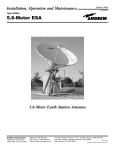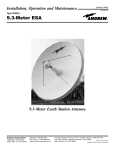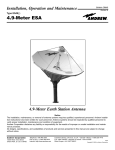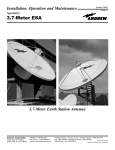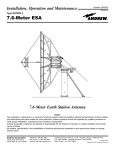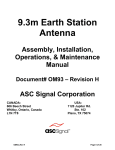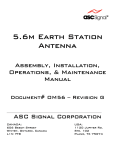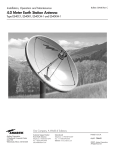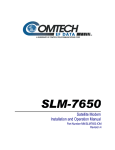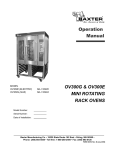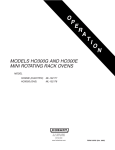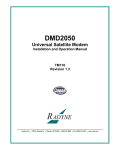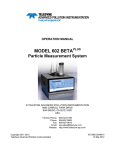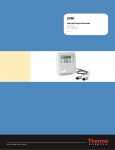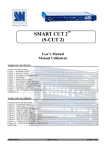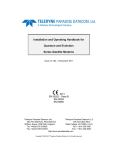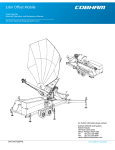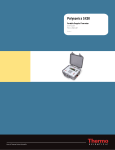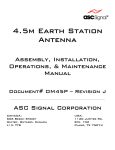Download Andrew ES73 User's Manual
Transcript
Installation, Operation and Maintenance Bulletin OM73 Revision F Type ES73( ) 7.3-Meter ESA 7.3-Meter Earth Station Antenna Andrew Corporation 10500 West 153rd Street Orland Park, IL U.S.A. 60462 Telephone: 708-349-3300 FAX (U.S.A.): 1-800-349-5444 Internet: http://www.andrew.com Customer Service, 24 hours: U.S.A. • Canada • Mexico: 1-800-255-1479 U.K.: 0800 250055 • Republic of Ireland: 1 800 535358 15 August, 2005 Other Europe: +44 1592 782612 Copyright © 2005 by Andrew Corporation Table of Contents Introduction Introduction. . . . . . . . . . . . . . . . . . . . . . . . . . . . . . . . . . . . . . . . . . . . . . . . . . . . . . . . . . . . . . . . . . . . . . . . 3 Proprietary Data . . . . . . . . . . . . . . . . . . . . . . . . . . . . . . . . . . . . . . . . . . . . . . . . . . . . . . . . . . . . . . . . 4 Information and Assistance. . . . . . . . . . . . . . . . . . . . . . . . . . . . . . . . . . . . . . . . . . . . . . . . . . . . . . . . 4 Notice . . . . . . . . . . . . . . . . . . . . . . . . . . . . . . . . . . . . . . . . . . . . . . . . . . . . . . . . . . . . . . . . . . . . . . . . 4 Technical Assistance . . . . . . . . . . . . . . . . . . . . . . . . . . . . . . . . . . . . . . . . . . . . . . . . . . . . . . . . . . . . 4 How to Use This Manual Overview . . . . . . . . . . . . . . . . . . . . . . . . . . . . . . . . . . . . . . . . . . . . . . . . . . . . . . . . . . . . . . . . . . . . . . . . . . 5 Getting Started Overview . . . . . . . . . . . . . . . . . . . . . . . . . . . . . . . . . . . . . . . . . . . . . . . . . . . . . . . . . . . . . . . . . . . . . . . . . . 6 Content . . . . . . . . . . . . . . . . . . . . . . . . . . . . . . . . . . . . . . . . . . . . . . . . . . . . . . . . . . . . . . . . . . . . . . . 5 Warnings . . . . . . . . . . . . . . . . . . . . . . . . . . . . . . . . . . . . . . . . . . . . . . . . . . . . . . . . . . . . . . . . . . . . . . 6 Recommended Tools . . . . . . . . . . . . . . . . . . . . . . . . . . . . . . . . . . . . . . . . . . . . . . . . . . . . . . . . . . . . 7 Parts Verification . . . . . . . . . . . . . . . . . . . . . . . . . . . . . . . . . . . . . . . . . . . . . . . . . . . . . . . . . . . . . . . . 8 Reporting Equipment Loss or Damage . . . . . . . . . . . . . . . . . . . . . . . . . . . . . . . . . . . . . . . . . . . . . . 8 Reporting Visible Loss or Damage. . . . . . . . . . . . . . . . . . . . . . . . . . . . . . . . . . . . . . . . . . . . . . . . . . 8 Reporting Concealed Damage. . . . . . . . . . . . . . . . . . . . . . . . . . . . . . . . . . . . . . . . . . . . . . . . . . . . . . 8 Inventory Equipment Received . . . . . . . . . . . . . . . . . . . . . . . . . . . . . . . . . . . . . . . . . . . . . . . . . . . . 8 Returning Equipment . . . . . . . . . . . . . . . . . . . . . . . . . . . . . . . . . . . . . . . . . . . . . . . . . . . . . . . . . . . . 9 Installation Procedures Overview . . . . . . . . . . . . . . . . . . . . . . . . . . . . . . . . . . . . . . . . . . . . . . . . . . . . . . . . . . . . . . . . . . . . . . . . . . 10 Foundation Preparation . . . . . . . . . . . . . . . . . . . . . . . . . . . . . . . . . . . . . . . . . . . . . . . . . . . . . . . . . . 10 A-325 Tensioning . . . . . . . . . . . . . . . . . . . . . . . . . . . . . . . . . . . . . . . . . . . . . . . . . . . . . . . . . . . . . . . 11 Tripod Ground Mount Assembly . . . . . . . . . . . . . . . . . . . . . . . . . . . . . . . . . . . . . . . . . . . . . . . . . . . 12 Azimuth Beam Assembly. . . . . . . . . . . . . . . . . . . . . . . . . . . . . . . . . . . . . . . . . . . . . . . . . . . . . . . . . .12 Support Legs Assembly . . . . . . . . . . . . . . . . . . . . . . . . . . . . . . . . . . . . . . . . . . . . . . . . . . . . . . . . . . 13 Panning Frame Assembly . . . . . . . . . . . . . . . . . . . . . . . . . . . . . . . . . . . . . . . . . . . . . . . . . . . . . . . . .16 Elevation Jackscrew Assembly . . . . . . . . . . . . . . . . . . . . . . . . . . . . . . . . . . . . . . . . . . . . . . . . . . . . 23 Azimuth Jackscrew Assembly. . . . . . . . . . . . . . . . . . . . . . . . . . . . . . . . . . . . . . . . . . . . . . . . . . . . . .25 Mount Assembly . . . . . . . . . . . . . . . . . . . . . . . . . . . . . . . . . . . . . . . . . . . . . . . . . . . . . . . . . . . . . . . . 25 Reflector/Subreflector/Feed Assembly. . . . . . . . . . . . . . . . . . . . . . . . . . . . . . . . . . . . . . . . . . . . . . . 30 Feed/Waveguide Assembly. . . . . . . . . . . . . . . . . . . . . . . . . . . . . . . . . . . . . . . . . . . . . . . . . . . . . . . . 30 Reflector/Backstructure Assembly . . . . . . . . . . . . . . . . . . . . . . . . . . . . . . . . . . . . . . . . . . . . . . . . . .36 Subreflector Strut Assembly . . . . . . . . . . . . . . . . . . . . . . . . . . . . . . . . . . . . . . . . . . . . . . . . . . . . . . 44 Reflector to Ground Mount Assembly. . . . . . . . . . . . . . . . . . . . . . . . . . . . . . . . . . . . . . . . . . . . . . . . 48 Subreflector Assembly and Adjustment . . . . . . . . . . . . . . . . . . . . . . . . . . . . . . . . . . . . . . . . . . . . . 50 Cross-Axis Grounding Kit . . . . . . . . . . . . . . . . . . . . . . . . . . . . . . . . . . . . . . . . . . . . . . . . . . . . . . . . 52 Operation Overview . . . . . . . . . . . . . . . . . . . . . . . . . . . . . . . . . . . . . . . . . . . . . . . . . . . . . . . . . . . . . . . . . . . . . . . . . . 54 Acquiring A Satellite . . . . . . . . . . . . . . . . . . . . . . . . . . . . . . . . . . . . . . . . . . . . . . . . . . . . . . . . . . . . . 54 Subreflector Adjustment . . . . . . . . . . . . . . . . . . . . . . . . . . . . . . . . . . . . . . . . . . . . . . . . . . . . . . . . . .58 Preventive Maintenance Overview . . . . . . . . . . . . . . . . . . . . . . . . . . . . . . . . . . . . . . . . . . . . . . . . . . . . . . . . . . . . . . . . . . . . . . . . . . 59 General Cleaning . . . . . . . . . . . . . . . . . . . . . . . . . . . . . . . . . . . . . . . . . . . . . . . . . . . . . . . . . . . . . . . 59 Electrical Parts. . . . . . . . . . . . . . . . . . . . . . . . . . . . . . . . . . . . . . . . . . . . . . . . . . . . . . . . . . . . . . . . . . 59 Mechanical Parts. . . . . . . . . . . . . . . . . . . . . . . . . . . . . . . . . . . . . . . . . . . . . . . . . . . . . . . . . . . . . . . . 60 Inspection. . . . . . . . . . . . . . . . . . . . . . . . . . . . . . . . . . . . . . . . . . . . . . . . . . . . . . . . . . . . . . . . . . . . . .60 Local Control/Motor Drive Controller. . . . . . . . . . . . . . . . . . . . . . . . . . . . . . . . . . . . . . . . . . . . . . . . 60 Antenna . . . . . . . . . . . . . . . . . . . . . . . . . . . . . . . . . . . . . . . . . . . . . . . . . . . . . . . . . . . . . . . . . . . . . . . 61 Drive System Voltage and Current Checks. . . . . . . . . . . . . . . . . . . . . . . . . . . . . . . . . . . . . . . . . . . .63 Preservation of Component Parts. . . . . . . . . . . . . . . . . . . . . . . . . . . . . . . . . . . . . . . . . . . . . . . . . . . 65 Aluminum Parts . . . . . . . . . . . . . . . . . . . . . . . . . . . . . . . . . . . . . . . . . . . . . . . . . . . . . . . . . . . . . . . . 65 Galvanized Surfaces . . . . . . . . . . . . . . . . . . . . . . . . . . . . . . . . . . . . . . . . . . . . . . . . . . . . . . . . . . . . . 65 Lubrication . . . . . . . . . . . . . . . . . . . . . . . . . . . . . . . . . . . . . . . . . . . . . . . . . . . . . . . . . . . . . . . . . . . . 65 Jackscrews/Motors . . . . . . . . . . . . . . . . . . . . . . . . . . . . . . . . . . . . . . . . . . . . . . . . . . . . . . . . . . . . . . 66 Gear Motor/Housing Fill Drain Requirements . . . . . . . . . . . . . . . . . . . . . . . . . . . . . . . . . . . . . . . . . 66 2 Table of Contents 7.3-Meter Earth Station Antenna Introduction Like all Andrew earth station antennas, the 7.3-Meter Earth Station Antenna provides high gain and exceptional pattern characteristics. The electrical performance and exceptional versatility provides the ability to configure the antenna with your choice of linearlyor circularly-polarized 2-port or 4-port combining network. That versatility is provided at the time of initial purchase, as well as in the future, as your satellite communication requirements evolve. The aluminum reflector is precision formed for accuracy and strength requiring minimal assembly. The reflector assembly is 24-feet (7.3-meters) in diameter and segmented in a sixteen piece configuration to reduce shipping volume and facilitate transport to remote sites. Reflector panels are conversion coated and painted with a highly reflective white paint. The versatile tripod mount can be purchased with either manual or motorizable capabilities. The tripod mount features 180 degree azimuth coverage in three continuous 120 degree overlapping ranges and executes 85 degree (5 - 90 degree) continuous elevation adjustment. This large adjustment range provides non-critical foundation orientation and the ability to view geostationary satellites from horizon-to-horizon, from any location worldwide. The motorizable tripod mount features self-aligning bearings for the elevation pivots, resulting in "zero" backlash. This mount can be operated manually, but has the ability to be upgraded for motorized operation, including steptracking/Smartrack™ applications. The motorizable mount type is indicated by the ES73 or ES73HS letters within the antenna type number. The addition of the letter "HS" within the antenna type number indicates that the mount includes High-Speed azimuth/elevation machine jackscrews. The azimuth/elevation jackscrews are equipped for integration with the optional motor drive systems. A cross-axis grounding kit is supplied with each mount to ensure electrical interconnectivity of the complete structure. The aluminum enclosure and hot-dipped galvanized steel mount maintain pointing accuracy and ensures durability and reliability. The antenna and standard manual mount with enclosure will survive 125 mph (200 km/h) wind, in any position of operation, without damage or permanent deformation in moderate coastal/industrial areas. Severe conditions require additional protection. Andrew provides a complete line of available options, including motor drive systems (with power interfaces addressing domestic and international standards), remote microprocessor antenna control for motor drive systems, pressurization equipment, and interconnecting HELIAX® cables and waveguide. 3 Introduction Proprietary Data The technical data contained herein is proprietary to Andrew Corporation. It is intended for use in operation and maintenance of Andrew supplied equipment. This data shall not be disclosed or duplicated in whole or in part without express written consent of Andrew Corporation. Information and Assistance Andrew Corporation provides a world-wide technical support network. Refer to the technical assistance portion of this this manual for the contact numbers appropriate to your location. Notice The installation, maintenance, or removal of antenna systems requires qualified, experienced personnel. Andrew installation instructions have been written for such personnel. Antenna systems should be inspected by qualified personnel to verify proper installation, maintenance and condition of equipment. Andrew Corporation disclaims any liability or responsibility for the results of improper or unsafe installation and maintenance practices. All designs, specifications, and availabilities of products and services presented in this manual are subject to change without notice. Copyright © 2005, Andrew Corporation Technical Assistance 24-hour Technical Assistance For technical assistance, call the following numbers at anytime. Call From Call To Telephone Fax North America (toll free) U. S. A. 1+800-255-1479 1+800-349-5444 Any Location (International) U. S. A. 1+708-349-3300 1+708-349-5410 Customer Service Center The Andrew Customer Service Center gives you direct access to the information and personnel service you need, such as the following: • Place or change orders • Check price and delivery information • Request technical literature You can call from any of the following: Call From Telephone Fax North America 1+800-255-1479 (toll free) 1+800-349-5444 (toll free) United Kingdom 0800-250055 (toll free) 44-118-9366-777 Australia 1-800-803-219 (toll free) 61-3-93579110 China 00-800-0-255-1479 00-800-0-349-5444 New Zealand 0800-441-747 (toll free) 61-3-3579110 Hong Kong 001-800-0-255-1479 002-800-0-349-5444 4 Introduction How to Use This Manual Overview The scope of this manual is intended to provide station personnel with the base installation, operation, and maintenance requirements necessary for a 7.3-Meter C-, X- or KuBand Earth Station Antenna. This manual provides a convenient reference for authorized operator/service personnel requiring technical information on general system or specific subsystem equipment. The tables and figures presented in this manual are used as communication aids for the installation, operation, and maintenance of the 7.3-Meter Earth Station Antenna. These tables and figures instantly convey messages, as well as make the procedures easier to understand. This manual uses tables and figures for the following references: • Tables The tables allow you to locate information quickly and easily. • Drawings The drawings supplement the installation instructions by using a combination of graphics and verbage to assist you in simplifying complex procedures and clarifying components. • Photographs The photographs compliment the installation instructions by providing actual examples of the steps being performed, which allow you to view the installation progress in the proper sequence. Content The manual is divided into five distinct sections, each dealing with a specific technical topic relating to either system or component subsystem information. The sections contained in this manual are described and listed under the following technical headings: • How to Use Describes the manual's purpose, content, and communication aids. This Manual Additionally, this section lists the related documentation for the 7.3Meter Earth Station Antenna. • Getting Started • Installation Procedures • Operation Provides the preliminary information needed to perform a successful installation. This section should be reviewed prior to the installation. The warnings, recommended tools, parts verification, instructions on reporting lost or damaged equipment, and installation checklist are located in this section. Provides the procedures for the different phases of a 7.3-Meter Earth Station Antenna base installation. This section will help you easily find requirements for an individual task, as well as displays the sequence for each task execution. Describes the controls, functions, and general operating procedures required for proper operation of the 7.3-Meter Andrew Earth Station Antenna. • Preventive Describes preventive maintenance procedures that are required to Maintenance maintain proper functional operation of your new Andrew Earth Station Antenna. 5 How to Use This Manual Getting Started Overview The installation, operation, and maintenance of the 7.3-Meter Earth Station Antenna requires qualified and experienced personnel. Andrew installation, operation, and maintenance instructions are illustrated for such personnel. Additionally, the antenna should be inspected by qualified personnel to verify proper installation, maintenance, and condition of equipment as described in Preventive Maintenance. The basic equipment and accessories are either manufactured or design controlled by Andrew Corporation. The prerequisite information necessary for the 7.3-Meter Earth Station Antenna can be found in this section. Furthermore, this section should be reviewed BEFORE performing the installation, operation, or maintenance. Recommended warnings, recommended tools, and the antenna parts can be verified and/or determined with such a review. Warnings When installing the 7.3-Meter Earth Station Antenna, be conscious of the recommended warnings presented below. For further information or clarification of this information, contact the Customer Service Center. The recommended warnings are as follows: 1. Electrical shock from voltages used in this antenna system may cause personal injury or death. Prior to making any electrical connections or performing maintenance or repair, ensure that the power is removed. Electrical connections should be made only by qualified personnel in accordance with local regulations. 2. Installation of antennas may require persons to work at elevated work stations. Whenever persons are working at eight or more feet above the ground and not on a guarded platform, they should wear safety belts with at least one (preferably two) lanyards. 3. Never stand underneath any object while it is being lifted. 4. Always wear a hard hat, especially if someone is above you. 5. Make sure no person is in or under the reflector while it is being lifted or positioned; personal injury can result if the reflector assembly falls. 6. Personnel should never be hoisted in or out of the reflector by the crane; personal injury may result. 7. Andrew earth station antennas supplied to standard product specifications will survive 125 mph winds in any operational position in moderate coastal/industrial areas. Severe conditions require additional protection. Should it be expected that winds will exceed 125 mph, it is recommended that Andrew antennas be steered to specific azimuth and elevation orientations to minimize wind forces upon the structure and thereby increase the probability of survival. 8. It is recommended that all cross-axis waveguide and coaxial cables are secure such that high winds will not cause excessive flexing. Position the antenna to an elevation of 90 degrees. The azimuth jackscrew should be placed in the center of its travel. 9. When the antenna is transmitting, severe eye injury or injury to other parts of the body can result from exposure to radio frequency (RF) energy. The antenna must be turned off before entering the area in front of the reflector and near the feed. 6 Getting Started NOTE: Failure to follow an installation procedure could result in damage to equipment or personal injury. Additional warnings will be displayed throughout this manual for your awareness. These warnings can be identified in warning boxes as shown in the following sample. Andrew disclaims any liability or responsibility for the results of improper or unsafe installation, operation, or maintenance practices. Recommended Tools Andrew supplies all appropriate hardware/parts required for the installation of your 7.3Meter Earth Station Antenna. All tools necessary for the installation process should be provided by the installation crew. Andrew recommends the following tools to be used for a proper installation of the 7.3-Meter Earth Station Antenna. Tool Size Open End or Combination Wrenches Quantity 5/16 Inch 7/16 Inch 9/16 Inch 7/8 Inch 3/4 Inch 1/2 Inch 1-1/4 Inch Crane 1 Ton Minimum Capacity, extended end Nylon Web Slings (2000 pound breaking strength) 3 Inch by 14 Foot Rope or Cord (2000 pound breaking strength) 50 Foot Shackles 5/8 Inch Ladder 10 Foot Extension Drive Sockets 1/16 Inch 9/16 Inch 7/8 Inch 3/4 Inch 1-1/4 Inch Breaker Bar 1/2 Inch Spud Wrenches 1-1/16 Inch 1-1/4 Inch Screw Driver Standard Phillips Allen Wrench 7/64 Inch 3/16 Inch 1/4 Inch Tape Measure (or other measuring device) Standard Felt-tip Marker (or other marking device) Standard Hammer Standard Rubber Mallet Standard Pry Bar Standard Tin Snips Standard Safety Gloves (each installer) Standard 2 2 2 2 2 2 1 1 2 1 2 1 1 1 1 1 1 1 1 1 1 1 1 1 1 1 1 1 1 1 1 1 Table 2-1. Recommended Tools 7 Getting Started Parts Verification Reporting Equipment Loss or Damage Reporting Visible Loss or Damage Andrew Corporation thoroughly inspects and carefully packs all equipment before shipment. If you find that there are missing components, please notify Andrew Corporation immediately by contacting the Customer Service Center (refer to page 4). If you find that there was damage caused to the equipment during the shipping process, a claim should be filed with the carrier. Follow the "Reporting Visible Loss or Damage" or "Reporting Concealed Damage" procedures when filing a claim with the carrier. Make a note of any loss or evidence of external damage on the freight bill or receipt, and have it signed by the carrier's agent. Failure to adequately describe such external evidence of loss or damage may result in the carrier refusing to honor a damage claim. The form required to file such a claim will be supplied by the carrier. Reporting Concealed Damage Concealed damage means damage which does not become apparent until the unit has been unpacked. The contents may be damaged in transit due to rough handling, even though the carton may not show external damage. If you discover damage after unpacking the unit, make a written request for an inspection by the carrier's agent, then file a claim with the carrier since such damage is most likely the carrier's responsibility. Inventory Equipment Received After opening your shipment, an inventory of the parts should occur immediately. Check each item received in your shipment against the packing slip included with the shipment. If any items are missing, please refer to page 9 for step-by-step instructions on how to properly report the equipment loss. 8 Getting Started Returning Equipment Andrew Corporation tries to ensure that all items arrive safe and in working order. Occasionally, despite these efforts, equipment is received which is not in working condition. When this occurs, and it is necessary to return the equipment to Andrew Corporation for either repair or replacement, return can be expedited by following the procedure listed below: Step 1 Call the Andrew Customer Service Center and request a Return Material Authorization (RMA) number, as well as an address to forward the material. Step 2 Tag or identify the defective equipment, noting the defect or circumstances. Also, be sure to write the RMA number on the tag. It would be helpful to reference the sales order and purchase order, as well as the date the equipment was received. Step 3 Pack the equipment in its original container with protective packing material. If the original container and packing material are no longer available; pack the equipment in a sturdy corrugated box, and cushion it with appropriate packing material. Step 4 Be sure to include the following information when returning the equipment: • Your Company Name • Your Company Address • City, State, and Zip Code • Telephone Number • RMA Number • Problem Description • Contact Name NOTE: Absence of the RMA number will cause a delay in processing your equipment for repair. Be sure to include the RMA number on all correspondence. Step 5 Ship the equipment to Andrew Corporation using UPS, U.S. Postal Service, or other appropriate carrier; freight prepaid and insured. The material should be forwarded to the address given by the Andrew contact in Step 1. 9 Getting Started Installation Procedures Overview This section provides installation procedures for the 7.3-Meter Andrew Earth Station Antenna. The installation procedures include instructions on the following antenna components: • Mount • Reflector-to-Mount Assembly • Reflector • Enclosure Foundation Preparation • Subreflector • Feed System (C-, X- or Ku-band) Before beginning the installation process on the ground mount assembly, ensure that the foundation has been prepared. Foundation specifications are provided by Andrew and may be used as a reference by civil engineering personnel when preparing the foundation for local soil conditions. These specifications are available before the shipment arrives by contacting the Customer Service Center or your Account Manager. • Foundation should be dimensioned as detailed in Figure 1. • Sweep foundation clear of any dirt or debris. • To ensure smooth surface for mount, scrape foundation pads as shown in Figure 2. • Studs should extend 3 in. above the surface and are 7/8 in. in diameter • Apply stick wax to stud threads to ease later connections. Figure 1 Figure 2 10 Installation Procedures A-325 Tensioning During the installation process, there are several references to the A-325 hardware tensioning procedure. The A-325 hardware must be properly tensioned to avoid slippage between bolted surfaces under high loads. Slippage can cause the corresponding assembly to move, causing antenna misalignment. When designated, the A-325 hardware should be tightened according to the following tensioning procedure. NOTE: Tensioned bolts are for final connections only and should not be loosened for reuse. Step 1 Lubricate the bolt threads with the provided stick wax to reduce friction. Step 2 Insert the bolt, and add a flat washer—if required. Do not allow wax under the flat washer. Step 3 Add the nut, and finger tighten. Step 4 After the connections are complete, tighten the bolts until the surfaces are joined and the nuts are snug (for example, full effort of a person using an ordinary spud wrench). Do not proceed with Steps 5 and 6, unless the connection is final and is not intended to be loosened again. Note: If the bolts are loosened after Steps 5 and 6, discard and replace with new hardware. Step 5 Using a felt-tip marker, mark the nuts and the ends of the bolts with a straight line as shown in Figure 3-1a and Figure 3-1b. Step 6 Tighten the nuts further with an extra long wrench until the nuts are moved 1/3 turn (120 degrees) as shown in Figure 3-1a for bolt lengths less than four diameters and 1/2 turn (180 degrees) as shown in Figure 3-1b for bolt lengths over four diameters. Use Felt Marker Before Tensioning After Tensioning Figure 3-1a: A-325 Tensioning Procedure For bolts less than 4 diameters 11 Use Felt Marker Before Tensioning After Tensioning Figure 3-1b: A-325 Tensioning For bolts over four diameters Installation Procedures Tripod Ground Mount Assembly The three-point mount is an elevation-over-azimuth mount optimized for geostationary satellite applications. The mount enables continuous elevation adjustment from 5 to 90°. Azimuth adjustment is ±90° and divided into three 120° ranges with 30° overlap. Follow the subsequent procedures for proper installation of tripod ground mount assembly. Azimuth Beam Assembly Step 1 All ground mount hardware is type A-325. Lubricate all A325 bolt threads with supplied stick wax. Note: Do not tighten hardware until ground mount installation is complete unless otherwise instructed. Step 2 Attach 200056 and 200057 supports to upper portion of 201408 beam assembly as shown in Figure 3. • Use 7/8 x 2-1/4 in (57 mm) hardware Figure 3 Step 3 Raise 201408 azimuth beam assembly and attach to front foundation pad as shown in Figure 4. • Use 7/8 in. flatwashers and hex nuts Note: Hex nuts and flatwashers supplied with 201630 anchor bolt kit Figure 4 12 Installation Procedures Support Legs Assembly Step 1 Attach 201327A joint assembly to 201313A beam assembly as shown in Figure 5. Attach 200083 angles to 201313A beam assembly as shown in Figure 5. • Use 7/8 x 2-1/4 in (57 mm) bolts and nuts for each connection Figure 5 Step 2 Attach 200088A joint assembly to 201313A beam assembly as shown in Figure 6. • Use 7/8 x 2-1/4 in (57 mm) bolts and nuts Figure 6 13 Installation Procedures Step 3 Raise 201313A beam assembly to upright position and attach 201315 supports to 201327A joint assembly as shown in Figure 7. • Use 7/8 x 2-1/4 in (57 mm) bolts and nuts • Insert bolts from 201327A joint assembly to supports • Supports should be installed back-to-back with the flat of angle facing upwards • Tighten supports until assembly can support itself 201315 Supports Figure 7 Step 4 Attach 201301/201302 rear pad assembly to 201315 supports as shown in Figures 8 thru 10. • Use 7/8 x 2-1/4 in (57 mm) bolts and nuts • Insert bolt from inside of rear pad assembly to outside of support • Supports should be installed back-to-back with the edges forward and the flats of angles facing rear Figure 8 14 Installation Procedures Step 5 Attach 201314 supports to 201301/201302 rear pad assemblies and 201273 joint assembly as shown in Figures 9 and 10. • Use 7/8 x 2-1/4 in (57 mm) bolts and nuts • Insert bolt from inside of joint assembly to outside of support • Supports should be installed back-to-back with the edges forward and the flats of angles facing rear Figure 9 Step 6 Attach 201317 supports between angle pairs as shown in Figure 10. Select corresponding mounting holes so that 201317 supports are parallel to 201313A beam assembly. • Use 7/8 x 2-3/4 in (70 mm) hardware • Supports attached with edges inward and flats facing up. Figure 10 15 Installation Procedures Panning Frame Assembly Step 1 Attach 201487 panning frame to 221384 azimuth pivot assembly as shown in Figures 11 and 12. Note: Ensure pivot assembly resolver/limit switch mounting holes are downward. • Use 7/8 x 2-1/4 in (57 mm) hardware and apply supplied RTV to flange surfaces as indicated • Bolts should connect from panning frame to pivot assembly Figure 11 Figure 12 16 Installation Procedures Step 2 Attach 221608 joint assemblies to panning frame as shown in Figures 13 and 14. • Use 7/8 x 2-1/4 in (57 mm) hardware • Insert bolts from panning frame to joint assembly Figure 13 Figure 14 17 Installation Procedures Step 3 Attach 201316 support pairs to 221608 joint assemblies as shown in Figure 15. • Place supports back-to-back with edges out and flat of angle inward • Install 45967 spacer at midpoints of support pairs • Use 7/8 x 2-1/4 in (57 mm) hardware for each connection 201316 Supports Figure 15 Step 4 Attach 221345 azimuth pivot assembly to 201316 support pairs. Attach 201596 mounting plates to 221345 azimuth pivot assembly tab as shown in Figure 16. • Use 7/8 x 2-1/4 in (57 mm) hardware for each connection • Insert bolts from rear of pivot assembly to connect supports 201596 Mounting Plates 221345 Azimuth Pivot Assembly 201316 Supports Figure 16 18 Installation Procedures Step 5 Attach 201770 plate connecting 201484/201484-2 extension assembly to 201487 panning frame as pictured in Figure 17. • Use 7/8 x 2-1/4 in (57 mm) hardware • Insert bolts from inside panning frame assembly 201770 Plate 201487 Panning Frame 201484/201484-2 Extension Assembly Figure 17 Step 6 Attach 201488 outrigger plate to opposite end of 201487 panning assembly. Attach 201481/201482 supports to outrigger plate as shown in Figure 18. • Use 7/8 x 2-1/4 in (57 mm) hardware • Insert bolts from supports to the outrigger plate 201487 Panning Frame 201488 Outrigger Plate 201481 Support 201482 Support Figure 18 19 Installation Procedures Step 7 Attach second 201488 outrigger plate to 201487 panning frame assembly as shown in Figure 19. • Use 7/8 x 2-1/4 in (57 mm) hardware • Insert bolts from inside assembly to outrigger plate 201488 Outrigger Plate Figure 19 Step 8 Attach 221721 elevation axis assembly to 201487 panning frame assembly and 221608 joint assemblies as shown in Figures 20 and 21. • Use 7/8 x 2-1/4 in (57 mm) hardware • Insert bolts from elevation axis assembly to panning frame assembly and joint assembly 221721 Elevation Axis Assembly 201487 Panning Frame Figure 20 20 Installation Procedures Figure 21 Step 9 Attach 301741 right tripod joint bracket and 301742 left tripod joint bracket to 221721 elevation axis assembly as shown in Figure 22. • Use 7/8 x 2-1/4 in (57 mm) bolt, flatwasher under bolt and under nut, and nut • Insert bolts from elevation axis assembly to tripod joint brackets 301741/301742 Tripod Joint Bracket 221721 Elevation Axis Assembly Figure 22 21 Installation Procedures Step 10 Attach 300026 tripod channel legs to tripod joint brackets as shown in Figure 23. • Use 7/8 x 2-1/4 in (57 mm) bolt, flatwasher and nut • Insert bolts from channel leg to joint bracket 300026 Tripod Channel Legs 301741/301742 Tripod Joint Brackets Figure 23 Step 11 Attach 301772 tripod tube weldment to 300026 tripod channel legs as shown in Figure 24. • Use 7/8 x 2-1/4 in (57 mm) bolt, flatwasher and nut • Insert bolt from channel leg to tube weldment 301772 Tripod Tube Weldment 300026 Tripod Channel Legs Figure 24 22 Installation Procedures Elevation Jackscrew Assembly Step 1 Attach 301771/301736 elevation jackscrew assembly to 201596 mounting plates as shown in Figure 25. Tighten connection. • Use 7/8 x 2-1/2 bolts and nuts Figure 25 Step 2 Loosen rubber boot from end of jackscrew. Turn elevation drive screw to extend jack to dimension 67.7 in (1719 mm) as shown in Figure 26. Apply grease to screw shaft. Reattach rubber boot. 67.7” (1719 mm) Figure 26 23 Installation Procedures Step 3 Prop 301771/301736 elevation jackscrew up to align with 301772 tripod tube weldment as shown in Figure 27. 301771/301736 Elevation Jackscrew Figure 27 Step 4 Attach 301771/301736 elevation jackscrew to 301772 tripod tube weldment as shown in Figure 28. • Use 7/8 x 5-1/4 (133 mm) bolt. Fasten with heavy hex nut and flatwasher according to A-325 procedure with the exception of tightening the nut 1/2 turn from snug condition. Tighten jam nut in accordance with A-325 procedure. Apply supplied Loctite to threads to act as locking nut. 301772 Tripod Tube Weldment Figure 28 24 Installation Procedures Azimuth Jackscrew Assembly Step 1 Insert 221923/223180 azimuth jackscrew tube into 221738 azimuth pivot assembly as shown in Figure 29. Insert jack carefully to prevent scratching jackscrew tube. Note: Ensure jackscrew assembly remains fully retracted at this time. 221738 221923/223180 Figure 29 Step 2 Apply RTV to flange surface as shown in Figure 29. Fasten jack to pivot using 7/8 x 23/4 in (70 mm) bolts and nuts. Mounting hardware is included with corresponding jack assembly hardware kit. Mount Assembly Step 1 Attach shackles to beam assembly as shown in Figure 30. Shackles 200088A Joint Assembly Figure 30 Step 2 Lift support legs to azimuth beam assembly. 25 Installation Procedures Step 3 Attach rear pad assemblies to rear foundation pads as pictured in Figure 31. 201327A 201313A Figure 31 Step 4 Connect beam assembly using 7/8 x 2-1/4 in (57 mm) hardware. Tighten supports to beam assembly per A-325 tensioning procedure. 26 Installation Procedures Step 5 Hoist elevation jackscrew/panning frame assembly to mount as shown in Figures 32A/32B. Figure 32A Figure 32B Step 6 Apply RTV to flange surfaces and attach 221384 azimuth pivot assembly to 201327A joint assembly with 7/8 x 2-1/4 hardware from pivot assembly to joint assembly as shown in Figure 32C. Note: Use one 7/8 by 2-3/4 inch (70 mm) bolt, flat washer and nut for later attachment of grounding cable. Figure 32C 27 Installation Procedures Step 7 Attach 221345 azimuth pivot assembly to 201408 beam assembly with a line of RTV around the plate and four 7/8 x 2-1/4 in (57 mm) holts inserted from pivot assembly to beam assembly as shown in Figure 33. Note: Use one 7/8 by 2-3/4 inch (70 mm) bolt, flat washer and nut for later attachment of grounding cable. 221345 7/8 x 2-1/4” (57 mm) Figure 33 Note: If optional motor drive system is included, install motors at this point. Refer to installation instructions provided with motor kits. Step 8 Refer to Figure 34. Position hoisting ropes on motor/jack assembly so jack will not roll when hoisted. Attach one rope to large motor frame next to gearbox to balance assembly; do not attach rope to small motor. Tie up loose conduit before lifting jack. Figure 34 Step 9 Raise 221923/223180 azimuth jackscrew and attach 221738 pivot assembly to 201273 joint assembly with 1 x 2-1/2 in (63 mm) hardware. Note: Mounting position of azimuth pivot jackscrew assembly is dependent upon azimuth range requirements and corresponds with mounting position of 201488 outrigger plate or extension assembly. 28 Installation Procedures Step 10 Extend jackscrew to meet outrigger assembly. Loosely attach outrigger plate to pin assembly in azimuth jackscrew as shown in Figure 35A. Note: Realignment of panning frame/pivot assembly may be necessary to ensure proper alignment of azimuth jackscrew pin. Snug panning frame/pivot assembly hardware and fully extend azimuth jackscrew to ensure binding does not occur throughout entire azimuth pivot range. 221923/223180 221738 Figure 35A Step 11 Refer to Figures 35A/35B. Loosen both setscrews in upper and lower collars of pin assembly at end of azimuth jack. Do not retighten these collars. Apply supplied Loctite to pin threads and nuts. Attach 1-1/2 in (38 mm) hex nuts to top and bottom of azimuth jackscrew pin assembly and securely tighten mounting hardware using 6 foot (1.8 m) lever arm. Tighten outrigger plate hardware. Upper and Lower Collars Figure 35B The tripod ground mount assembly is now completed with the necessary operational essentials. All ground mount options have separate instructional bulletins located in the parts kit that contain the option. The next step in the installation process is the reflector assembly. Proceed to the next page to begin installation of the reflector. 29 Installation Procedures Reflector/ Subreflector/ Feed Assembly Feed/Waveguide Assembly Step 1 Type A-325 hardware is utilized during the reflector attachment to the ground mount. Use of A-325 hardware eliminates slippage between mating surfaces under high loading conditions as well as the need for future retightening. Refer to the A-325 tensioning procedure in preceding installation text. CAUTION: Adhere to any special instructions stenciled on crate relative to crate opening, contents removal and/or personnel safety. Pre-assemble corresponding back strut assembly pairs (16) as shown in Figure 36 using 1/2 x 1-1/2 (38 mm) bolts, 77956 strut spacers, lockwashers and nuts. Do not tighten. Figure 36 Step 2 Remove drum assembly from crate. Lay drum assembly on its side on temporary supports as shown in Figure 37. Apply line of RTV sealant around feed opening. Figure 37 30 Installation Procedures Step 3 Align tabs on 77639 feed rotating tube assembly with corresponding tabs on drum assembly. Attach rotating tube to center of drum assembly using 3/8 x 1-3/4 in (44 mm) bolts, lockwashers and nuts as shown in Figure 38. Do not tighten. Figure 38 31 Installation Procedures Step 4 Attach 77874 feed supports between rotating tube tabs and corresponding drum tabs as shown in Figure 38. Fully tighten. • Use 1/2 x 1-1/8 (29 mm) shoulder bolts, lockwashers and nuts Note: Ensure shoulder bolts are fully seated and feed support angles are installed edge down with flats of angles facing upward. Step 5 Fully tighten flange to drum connection hardware. Step 6 Attach circular waveguide assembly to 201606 feed horn assembly as shown in Figure 39. Note: Deep recess end of mounting pipe flange should be oriented toward feed horn while shallow recess end should be toward rotating tube assembly. • Use 1/4 x 1 in (25 mm) bolts and lockwashers • Insert 10683-469 O-Ring spacer between assemblies as shown • Insert bolts from circular waveguide to feed horn Deep Recess Note: Typical C-Band Feed Horn Assembly Shown for Reference Only. Shallow Recess Figure 39 32 Installation Procedures Step 7 Attach 77646-2 feed horn mounting pipe to 201606/301808 feed horn assembly as shown in Figure 40. • Use 1/2 x 2-1/2 in (63 mm) hex screws, lockwashers and nuts • Insert bolts from feed horn to mounting pipe Figure 40 33 Installation Procedures Step 8 Install circular waveguide assembly through 77639 rotating tube assembly and attach feed horn/mounting pipe assembly to rotating tube as shown in Figure 41A. Install 201065A circular waveguide support assembly as shown in Figure 41B. • Use 1/2 x 2 in (51 mm) bolts, lockwashers and nuts • Insert bolts from mounting pipe to rotating tube Figure 41A 201065A Waveguide Support Equipment Enclosure Figure 41B 34 Installation Procedures Step 9 Rotate drum assembly into upright position. Level drum with shims until no side can bounce, as shown in Figure 42. Figure 42 35 Installation Procedures Reflector/ Backstructure Assembly Step 1 Attach back strut assemblies to lower drum ring brackets as shown in Figures 43 and 44. • Use 1/2 x 1-1/2 in (38 mm) bolts, lockwashers and nuts Figure 43 Figure 44 36 Installation Procedures Step 2 Remove entire end of panel crate to allow easy access and careful removal of reflector panels. • When transporting panels, support panel on side as packaged Step 3 Tie assembly down by knotting rope between lifting tabs and three 3 ft stakes as shown in Figure 45. This will prevent an unbalanced condition when adding panels one at a time. Figure 45 Step 4 Install reflector panel segment 1 with the center of the Andrew “flash” logo to upper drum ring assembly ring bracket 180° opposite tripod mounting holes as shown in Figures 46 and 47. Do not tighten. • Use 1/2 x 1-1/2 in (38 mm) bolt, lockwasher and nut • Use 9 ft (3 m) 2 x 4 to temporarily support perimeter of panel segment Note: Top of support should be padded to prevent damage to panel. Support should be placed on outside edge of panel opposite reflector segment tee section. Figure 46 37 Installation Procedures Center portion of Andrew “flash” logo Figure 47 38 Installation Procedures Step 5 Install back strut members to reflector segment tee section as shown in Figure 48. Use minimum torque to tighten hardware connecting back strut to reflector segment, reflector segment to upper drum ring assembly and back strut to lower ring drum assembly. • Use 1/2 x 1-1/2 in (38 mm) bolt, lockwasher and nut Note: Tighten only until lock washers are flattened. Figure 48 39 Installation Procedures Step 6 Repeat Steps 4 and 5 to install second panel adjacent to panel segment 1 as shown in Figures 49. Install panel seam hardware connecting panel segments 1 and 2 with step ladder. Do not tighten. • Use 5/16 x 3/4 in (19 mm) special bolts, 3/8 in flatwasher, 5/16 in lockwasher, and 5/16 in nut as shown in Figure 50. Important: Do not step on panel surface when installing panel seam hardware. Apply force only on panel seam. Figure 49 Figure 50 40 Installation Procedures Step 7 Install third panel segment (adjacent to first panel segment) according to Steps 4 thru 6 and Figure 51. Figure 51 Step 8 Continue installing panel segments as described in Steps 4 thru 7 in counter-clockwise direction as shown in Figure 52. Note: Panels are numbered and should be installed in proper sequence. Note: Ensure that 9 ft supports are used at every other panel segment. Figure 52 41 Installation Procedures Step 9 Step 10 Prior to installing panels 15 and 16 station a man on top of the drum assembly enclosure to install panel seam hardware. Care must be taken not to apply heavy weight to surface of panel segments. Note that there are 16 panel segments each with 21 bolt holes numbered 1-21 from the center out which form concentric rings around the inside of the reflector as shown in Figure 53. Beginning with the center flash panel (segment 1) tighten all panel seam hardware corresponding to bolt hole ring 11, located above reflector tee segment/back strut assembly connection. Continue tightening ring 11 reflector seam hardware working counterclockwise. Figure 53 Step 11 Tighten panel seam hardware along rings 10 and 12 simultaneously beginning with panel seam 1. Step 12 Tighten panel seam hardware along rings 9 and 13 simultaneously beginning with panel seam 1. Step 13 Tighten panel seam hardware along rings in pairs simultaneously beginning with rings 14 and 15 working toward the outside of the reflector to seam hardware ring 21. Step 14 Tighten panel seam hardware along rings in pairs simultaneously beginning with hardware rings 7 and 8 working toward the inside of the reflector down to seam hardware ring 1. 42 Installation Procedures Step 15 Beginning with panel seam 1, fully tighten hardware attaching panels to upper drum assembly ring, reflector tee segment to back strut assembly, back strut assembly to lower drum assembly ring and back strut assembly pairs. Continue tightening attaching hardware on all reflector segments. Step 16 Install 170147 quadrapod plates at positions indicated in Figure 54 according to procedure in Figure 55. Do not tighten hardware. • Use 1/2 x 1-1/4 in (32 mm) bolts lockwashers and nuts Quadrapod Plates Quadrapod Plates Figure 54 Figure 55 43 Installation Procedures Subreflector Strut Assembly Step 1 Attach subreflector strut assemblies to 170147 quadrapod plates as shown in Figures 56 and 57. Tighten hardware until snug only. • Use 1/2 x 1-1/2 in (38 mm) bolts, lockwashers and nuts Figure 56 44 Installation Procedures Figure 57 45 Installation Procedures Step 2 Attach subreflector strut assemblies to opposing sides of 77943 apex bracket as shown in Figures 58 and 59. • Use 1/2 x 1-1/4 in (32 mm) bolts, lockwashers and nuts Figure 58 Figure 59 46 Installation Procedures Step 3 Attach subreflector ring to corresponding strut assembly plates as shown in Figure 60. Ensure subreflector ring assembly is installed with indicated adjustment stud hole at 3 o’clock position as shown. Do not tighten mounting hardware. • Use 1/2 x 1-1/4 in (32 mm) holts, flatwashers, lockwashers and nuts Figure 60 Step 4 Fully tighten quadrapod plates to reflector segments, struts to quadrapod plates, struts to apex bracket, subreflector ring to strut assembly plates. Step 5 Screw 3/4 x 9 in (229 mm) adjustment studs into mounting holes on subreflector as shown in Figure 61. Install 3/4 in flatwashers, nuts and jam nut onto stud. Figure 61 47 Installation Procedures Reflector to Ground Mount Assembly Step 1 Attach 5/8 in (16 mm) shackles to three lifting tabs as shown in Figure 62. Attach 15 ft (4.5 m) tag lines to opposing quadrapod plates. Top Figure 62 Step 2 Raise reflector/backstructure assembly and align with corresponding mounting holes in drum and elevation axis assemblies using tag lines for proper guidance as shown in Figure 63. Attach rear of drum assembly to elevation axis assembly using 300037 spacers, 3/4 x 4 in (102 mm) bolt and nut assemblies and flat washers. Align mounting holes and attach forward leg of jack tripod to forward portion of drum assembly using 5/8 x 3 in (76 mm) bolt and nut assembly, clipped washers and cast spacer as shown in Figure 64. Securely tighten mounting hardware per A-325 Tensioning Procedure. Note: Required mounting hardware is included as part of reflector/backstructure hardware kit 300033. 48 Installation Procedures Figure 63 Figure 64 49 Installation Procedures Subreflector Assembly and Adjustment Step 1 Install subreflector subassembly to subreflector ring by inserting studs on subassembly into adjustment stud mounting holes as shown in Figure 65. • Use 3/4 in (19 mm) flatwasher, nut and jam nut NOTE: 5” (127mm) dimension shown is a starting reference only. Dimension will vary after adjustments are complete. Figure 65 Step 2 Refer to Figure 66. Measure and note the distance between either outermost angle clip bolt head and the subreflector rim. Obtain the corresponding measurements from the remaining subreflector struts, and adjust the subreflector mounting hardware (4 places) to achieve a maximum differential of 1/16 inch. Figure 66 50 Installation Procedures Step 3 Adjust subreflector hardware to obtain appropriate setting from surface of reflector at seam bolt ring #1 to bottom of subreflector rim in a radial plane as shown in Figure 67. Securely tighten adjustment hardware. Figure 67 Step 4 Repeat the adjustment procedure performed in Step 2, until all areas of the subreflector are uniform. Adjust the jam nuts, and securely tighten the adjustment hardware. 51 Installation Procedures Cross-Axis Grounding Kit Note: Thoroughly clean exposed portions of grounding cables, unplated portion of universal terminals and cor-responding mounting surfaces using a wire brush. Liberally apply supplied 203233-2 conductive grease to all connection surfaces prior to and after installation. Thoroughly remove conductive grease from hands and tools using soap and water. Step 1 Refer to Figure 68. Attach lugs to universal terminals at each end of 46373 grounding cables as shown, using 5/16 by 1 inch (25 mm) bolts, flat washers and nuts. Install grounding cables on 7/8 by 2-3/4 inch (70 mm) bolts at indicated positions. Figure 68 52 Installation Procedures Step 2 Refer to Figure 69. Attach lugs to universal terminals at each end of 46373 grounding cable as shown, using 5/16 by 1 inch (25 mm) bolts, flat washers and nuts. Attach cable to available hole in panning frame, using 7/8 by 2-1/4 inch (57 mm) bolt and nut. Attach other end of cable to existing 5/8 by 2 inch (51 mm) bolt on tripod as shown. Attach second grounding cable to other side of elevation axis/panning frame assembly. Step 3 Attach foundation grounding cable connectors to each mount leg. Cable attachment and foundation grounding system to be installed per local code. Step 4 Securely tighten all remaining ground mount/jack assembly hardware per A-325 hardware tensioning procedure. Figure 69 53 Installation Procedures Operation Overview After you have completed the assembly of your antenna, you are now ready to become operational. In order to operate the earth station antenna, you will need to direct it to the desired satellite adjusting both the elevation and azimuth angles appropriately. The following procedures provide details on how to correctly position your antenna on the desired satellite. Acquiring A Satellite There are several procedures that may be used to properly acquire the satellite. Andrew recommends that a spectrum analyzer be used. The following procedures provide explanation as to how to use the spectrum analyzer. While viewing the spectrum analyzer screen, a signal as shown in Figure 4-1 will probably be observed. Additionally, some transponder signals may be observed above the noise signal as shown. Figure 4-1: Minimum transponder Signal on Spectrum Analyzer 54 Operation The following steps provide the procedure for acquiring a satellite. Step 1 Begin by obtaining the correct Az/El pointing data for the satellite of interest based on specific calculations for this particular site. Step 2 Using an inclinometer placed on the enclosure drum surface, position the antenna to the specified elevation angle. Step 3 Manually move the antenna in the azimuth (scanning back-and-forth around the direction of the specified azimuth angle) to achieve the maximum (greatest amplitude) transponder signals. • Scan in one direction until the amplitude continues to diminish and then scan in the opposite direction until the same condition occurs. • Return to the position yielding the greatest amplitude. The maximum azimuth excursion from the original setting should not exceed plus or minus 1.5 degrees or the antenna may begin to access a different satellite. Step 4 With the antenna positioned in azimuth such that the transponder signals are maximized, follow the same procedure manually moving the antenna in elevation (scanning up-and-down) to further maximize the transponder signals. Step 5 Repeat this procedure alternating between the azimuth and elevation excursions of the antenna to peak the transponder signal amplitude. Step 6 With the antenna peaked in azimuth and/or elevation, check to see if you’re peaked on a sidelobe. Move the antenna in azimuth while observing the spectrum analyzer screen. Refer to Figure 4-2. Figure 4-2: Antenna Radiation Pattern Topographical Diagram with Plan View 55 Operation Step 7 Move the antenna in azimuth to obtain a null, then move ± in elevation to obtain a large peak signal. If not, move the antenna in the opposite azimuth direction through the peak and again move ± in elevation to obtain a large peak signal. If a larger peak is not found, you were on the main lobe. NOTE: The following explanation for polarization adjustment addresses the special case of full transponder signals. Some applications may include partial transponder signals. Step 8 If your antenna is equipped with a linear polarizer, the antenna is aligned in azimuth and elevation (signal maximized) and 24 transponder signals (12 horizontal and 12 vertical) are noted, the polarization adjustment is set incorrectly and must be modified. If 12 transponder signals are noted, they may or may not be the properly polarized signals. Therefore 24 transponder signals must be visually noted in order to determine the proper polarization setting. Step 9 Rotate the feed assembly clockwise until 24 transponder signals are noted and of approximately equal amplitude. NOTE: It is more accurate and visually easier to minimize the alternate set of transponder signals rather than maximizing the transponder of interest. Figure 4-3: Polarization at 45 degrees from Optimum Setting 56 Operation Step 10 With all 24 transponder signals of approximately equal amplitude appearing on the spectrum analyzer screen determine the specific antenna system and satellite parameters. Rotate the feed assembly as required until the appropriate (odd or even) transponder signals are maximized. Figure 4-4: Maximizing Odd Transponders Figure 4-5: Optimum Polarization Setting 57 Operation Subreflector Adjustment After the satellite has been acquired and testing has taken place with the spectrum analyzer, the subreflector may need to be adjusted to maximize optimum performance of your antenna. The following procedures should be followed if a subreflector adjustment is required to maximize optimum performance. NOTE: All INTELSAT Type Approved antennas do not require subreflector adjustment. Before proceeding, azimuth and elevation patterns should be conducted to determine the adjustments that need to be made. The goal is to achieve a high peak on the main lobe and even distances between the main lobe and sidelobes. NOTE: No adjustments should be made in the receive band. If your pattern dictates a need to adjust the azimuth angle(the left sidelobe requires adjustment), the west side (northern hemisphere) of the subreflector should be adjusted outward by loosening the screws on the subreflector and adjusting the left side (northern hemisphere) outward. An easy way to remember this adjustment feature is through the acronym WOLD (West Out Left Down). If your pattern dictates a need to adjust the elevation angle(the right sidelobe requires adjustment), the bottom side of the subreflector should be adjusted downward by loosening the screws between the subreflector and the struts and adjusting the bottom side of the subreflector downward. An easy way to remember this adjustment is through the acronym BOLD (Bold Out Left Down). Each of these adjustments should be repeated until each sidelobe is of equal distance from the peak of the mainlobe. After the BOLD and WOLD adjustments have been made, it may be necessary to adjust the main lobe. The goal is to achieve a high null depth (distance between lower intersection of sidelobes and top of main lobe) as shown in Figure 4-5. In order to adjust the main lobe pattern characteristics ALL subreflector adjustment screws should be adjusted at the same degree (Note: Because the azimuth and elevation adjustments have been set, it is very important that the null depth adjustment be carefully conducted. Be careful not to alter any previous adjustments that have been made to the subreflector. Follow the procedure listed below when adjusting the null depth of the main lobe. C-band feeds - Adjustment screws are 3/4 X 10. Move 1 turn per 1dB of imbalance. Ku-band feeds - Adjustment screws are 1/4 X 20. Move 1 turn per 1 dB of imbalance. All adjustments should be continued until the desired pattern is achieved. Upon completion the antenna should be properly aligned with the satellite for maximum performance. 58 Operation Preventive Maintenance Overview This section contains periodic preventive maintenance instructions for the 7.3-Meter Earth Station Antenna. Included in this section are inspection and preventive maintenance procedures including cleaning and lubrication, painting, and an operational voltage/current checkout procedure deemed within the capabilities of the average station technician. Refer to applicable vendor manuals for any repair procedures not included in this section yet designated as capable off being performed in the “field” rather than requiring specialized facilities, tools, and/or test equipment as well as technically trained personnel. An operational checkout procedure provides an accurate indication of the overall earth station performance and should be performed at intervals of approximately three months. This procedure is essentially performed during the various modes of normal operation of the earth station. In addition, the operational checkout procedure should be performed after any repairs or adjustments have been made, or whenever the earth station is suspected of degraded operation. If any discrepancy in performance exists and the condition cannot be readily remedied to return the earth station to a proper operating condition, the appropriate troubleshooting procedures should be referenced to locate the fault. After the trouble is determined and the repairs affected, a final operational checkout procedure should be performed to verify that all discrepancies have been corrected. The following paragraphs describe the inspection and preventive maintenance procedures for the earth station. These instructions include general cleaning and inspection, the preservation of metal parts and lubrication. Periodic replacement of assemblies or components as a preventive measure is not required. Malfunctions of the earth station can be traced to components, assemblies, and parts through the use of applicable troubleshooting procedures. General Cleaning Electrical Parts To prevent the excessive accumulation of dust and dirt as well as the removal of such contaminants, thoroughly clean the equipment whenever visually inspecting the earth station components. No special cleaning procedures are required. However, a thorough cleaning in accordance with the following procedures is required to assure continued trouble-free operation. Minor cleaning, such as the removal of dust and loose foreign particles can be accomplished by one of the following: • Vacuuming • Using a soft brush or lint-free cloth • Blowing out the dust and dirt with low pressure (5 to 25 psi), dry compressed air When using air to blow off the contaminants, either avoid or be careful when directing the air stream on delicate parts. To remove imbedded dirt, grease, or oil from electrical parts; use a 50 percent solution of isopropyl (rubbing) alcohol and apply with a soft bristle brush. It may be necessary to brush some parts vigorously with a stiff bristle brush to remove imbedded and hardened dirt particles. If possible, avoid excessive use of cleaning solvent on electrical insulation. After cleaning, allow the cleaned parts to dry for 10 to 15 minutes before placing the equipment into operation. Clean mechanical parts by first removing dust, dirt, and other loose contaminants with a 59 Preventive Maintenance Mechanical Parts Inspection Local Control/Motor Drive Controller scraper, stiff brush (bristle or wire in the case of rust or other corrosion), or cloth or compressed air at 25 to 40 psi. Any accumulated imbedded dirt, corrosion, grease, or oil deposits that require further cleaning may be removed with a bristle or wire brush and a cleaning solvent such as trichlorethylene or equal. After cleaning, allow cleaned parts to dry for 10 to 15 minutes before placing the equipment into operation. The frequency of inspection is contingent upon the user’s individual standards and the operational environment in which the earth station is located. However, a visual inspection of the earth station components should be performed at least semi-annually. Where there are no established wear limits, perform a visual inspection to locate worn or damaged parts which could cause improper functioning of the earth station. It is recommended that the mechanical and electrical inspection be performed on the assembled or partially disassembled equipment to determine the extent of disassembly required prior to completely disassembling a suspected malfunctioning component or module. In the absence of any special inspection requirements, operational tests are the most effective means in isolating parts and assemblies requiring further inspection. Any condition noted during inspection that may preclude continued proper operation of the earth station prior to the next scheduled inspection should be noted. The discrepant condition should be corrected (repaired or replaced) immediately or at the conclusion of the inspection procedure. Inspection of the local control/motor drive controller conforms generally to standard visual inspection procedures on electromechanical equipment. In addition to these standard procedures, perform the following checks and visual inspections for the specific conditions noted: • Check the front panel for illegible and indistinct panel markings. • Check the three position selector switches (Azimuth Slow/Fast, Elevation Slow/Fast, and Polarization CCW/CW) for smooth operation, audible clicking at each actuation (left to center and return) and spring return from right to center. For each of the two position selector switches (Azimuth-East/West, Elevation-Up/Down, and Local/Remote) check for smooth operation and audible clicking at each actuation. • Inspect all wiring and cables for discolorization and burned insulation, dirt, breaks, security of connection and other signs of deterioration. Examine connections for dirt, flux, corrosion, and mechanical defects. Check for loose or broken lacing and cut, brittle, abraided, frayed, or cracked insulation. • Examine connectors for corrosion, broken inserts and stripped threads. Check connector shells for distortion and dents, and contact pins for bends, misalignment, or other deformities. Check connector inserts for carbon tracking indicating arc-over. • Check all electrical components for dirt, cracks, chips, breaks, discoloration and other signs of deterioration and damage. A discolored, blistered, or burnt condition is evidence of overload. Measure actual value of suspect electrical components and compare against specified value. • Check transformer for an excessive wax deposit on the surface, discoloration, or a 60 Preventive Maintenance pungent odor indicative of burning vanish denoting overheating or a total breakdown. • Check all terminal boards for broken or missing terminals and stripped threads. Check tightness of lead attaching hardware. • Check each starter for a make-after-break provision through the release of one pushbutton as the alternate pushbutton is pressed. • Check the relays and contactors for free operation of the armatures and contact condition. The contacts are usable even though pitted, burned, worn, or discolored. The contacts or contactor or relay assembly should be replaced only when the contact material has been completely torn away or worn off. • Visually inspect all mechanical parts for freedom of operation without binding or interference. Check for security of all hardware and stripped or otherwise damaged threads. Check metallic parts for corrosion, dents, distortion, and other deformation. • Check for evidence of water inside the enclosure. If any water is in evidence, clean area thoroughly and check that all seals are intact and if not, use a coating of RTV-108 (silicone rubber sealant) to seal any exposed electrical fitting, bolt hole, or other possible water entry to the enclosed electrical components in order to maintain a waterproof condition. • Antenna Check or change humidity absorber. Inspection of the antenna conforms generally to standard visual inspection procedures performed on electromechanical equipment. In addition to these procedures, perform the following checks and visual inspections for the specific conditions noted: • Inspect all wiring and cables particularly the network to enclosure and enclosure to mount interfaces for discoloration and burned insulation, moisture entry, corrosion, dirt, breaks, security of connection, and other signs of deterioration. Examine connections for dirt, corrosion, and mechanical defects. Check for loose or broken lacing and cut, abraided, frayed, brittle, and cracked insulation. • Examine connectors for corrosion, broken inserts and stripped threads. Check connector shells for distortion and dents, and contact pins for bends, misalignment or other deformities. Check connector inserts for cracks, and carbon tracking, burns or charring indicating arc-over. • Check all electrical component for dirt, cracks, chips, breaks, discoloration, and other signs of deterioration and damage. A discolored, blistered, or burnt condition is evidence of overload. • Operate the azimuth and elevation drives as well as the feed rotation in both the plus 61 Preventive Maintenance and minus direction from the local control/motor drive controller at least once every three months during antenna down time. Check the mechanical limit switches provided at the end points stop the antenna and feed movement, and limit travel to prevent structural interference and damage. Check the mechanical limit switches for corrosion and water entry and the arm on each feed limit switch for free movement without binding. Be certain both feed rotation limit switch arms are not distorted and ride centrally on the actuating cam to open their corresponding limit switch. • Inspect the azimuth and elevation jackscrew boots for security of attachment at both ends, for abrasion, tears, cuts, brittleness and other damage that may expose the jackscrew to the environment (water, dust, etc.). Minor repairs can be made with RTV108 silicone rubber sealant. • Visually inspect the feed window for dirt and the feed, feed supports, feed window, and reflector for distortion, foreign object damage and environmental deterioration due to ice and snow, dust, rain, hail, and high winds, etc. which may cause electrical component and/or structural deformation. • Check the cable attachment to the resolvers and to the LNA or LNB’s and enclosure mount interface for security, the cable rouging for secure hanger attachment and the cable insulation for cuts, cracking, abrasion, and other deterioration. Check the LNA or LNB’s and the resolvers for a secure mechanical attachment. Ensure proper torquing of polarization drive gear box setscrews and appropriate tensioning of corresponding drive chain assembly, if applicable. • Check (if applicable) that the drain holes in the bottom of the enclosure are not obstructed and there is no evidence of water accumulation. Check the enclosure doors for proper closure and that the door seals are intact, not torn, abraided or otherwise damaged. Check that all other seals are intact and if not, use a coating of RTV-108 (silicone rubber sealant) to seal any exposed electrical fitting, bolt hold, or other possible water entry to electrical components in order to maintain a weatherproof condition. If the enclosure is provided with a vent fan, check for free operation of the fan blade. The fan bearings are permanently lubricated; any binding, abnormal noise or vibration necessitates replacement of he fan assembly. Check and replace the fan filter element if it appears dirty or obstructed with dust. • Visually inspect all mechanical parts for freedom of operation with no misalignment, binding or interference. Check all cabling for sufficient slack to prevent cable strain as well as adequate restraint to prevent abrasion or chaffing during antenna and feed movement. • Check security of antenna mounting and interconnecting assembly hardware. Be cer- 62 Preventive Maintenance tain all electrical grounding connections (including cross-axis grounding straps) are intact and secure, not corroded or broken. Thoroughly clean any noticeable corroded portions of grounding cables, unplated portion of universal terminals and corresponding mounting surfaces using a wire brush. Replace rather than tighten any loose A-325 structural hardware. The hardware distorts at initial installation and once loosened will not maintain the required high strength friction connection. All other assembly and installation hardware should be tightened to its original torqued condition. When installing new structural hardware, do not use a wrench with a lever arm longer than two feet. • Drive System Voltage and Current Checks Step 1 Step 2 Examine painted aluminum and galvanized surfaces and touch-up where required. At the conclusion of the installation procedure prior to turning the system over to the station facility, an installation acceptance check off sheet was prepared and duly signed off if installed by Andrew crew. Part of this check off included voltage readings retaken to determine if proper voltage was available. Current readings were also taken as a reference for future comparison to serve as a troubleshooting aid in determining possible equipment degradation and shortened life. Any current reading taken during the following procedure that varies by more than five percent from the pre-established reference values necessitates troubleshooting the particular system involved to determine the cause and required corrective action. Approximately every three months and during a period of down time, disconnect as applicable the RF transmitter and all power supplies. The main disconnect switch in the main load center box at the antenna site must be in the ON position and the LOCAL/REMOTE switch in the local control motor drive controller must be in the LOCAL position. Open the outer local control/motor drive controller door at the antenna site to gain access to the conductors supplying power to the azimuth, elevation, and polarization drive motors. NOTE: During the following procedures, the antenna drives (azimuth, elevation, and polarization) will be powered to rotate the antenna and feed in both directions of travel. Check that this condition can be tolerated from a safety as well as an operational standpoint, and that the electrical limits are not reached before the testing is concluded. Reaching an electrical limit before concluding a test necessitates rotating the antenna or feed in the opposite direction a sufficient distance to permit retesting in the desired direction. Step 3 Turn the FEED CCW/CW switch to either the CW or CCW position and while the feed is rotating, carefully use a clamp on ammeter in accordance with the ammeter manufacturer’s instructions to take current readings off each of the three conductors (phases) connected to the load side of the polarization motor circuit breaker. Record the current draw in the equipment log and compare the readings to the reference values entered in the installation/acceptance check off. If the readings differ by more than five percent, refer to appropriate troubleshooting information and perform applicable corrective action. Then take voltage readings off each of the three conductors; the readings should agree with each other within two percent. Repeat preceding step (3) with the FEED CCW/OFF/CW switch in the alternate operating position. 63 Preventive Maintenance Step 4 Step 5 Step 6 Step 7 Step 8 Step 9 Turn the AZIMUTH EAST/WEST switch to either position and while the antenna is rotating, carefully use a clamp on ammeter in accordance with the ammeter manufacturer’s instructions to take current readings off each of the three conductors (phases) connected to the load side of the azimuth drive motor circuit breaker. Record the current draw in the equipment log and compare the readings to the reference values entered in the installation/acceptance check off. If the readings differ by more than five percent, refer to appropriate troubleshooting information and perform applicable corrective action. Then take voltage readings off each of the three conductors; the readings should agree with each other—within two percent. Repeat steps (5) with the AZIMUTH EAST/WEST switch in the alternate operating position. Turn the ELEVATION DOWN/UP switch to either position and while the antenna is rotating, carefully use a clamp on ammeter in accordance with the ammeter manufacturer’s instructions to take current readings off each of the three conductors (phases) connected to the load side of the elevation drive motor circuit breaker. Record the current draw in the equipment log and compare the readings to the reference values entered in the installation/acceptance check off. If the readings differ by more than five percent, refer to appropriate troubleshooting information and perform applicable corrective action. Then take voltage readings off each of the three conductors; the readings should agree with each other within two percent. Repeat steps (7) with the ELEVATION DOWN/UP switch in the alternate operating position. If all voltage and current readings are within tolerance, close the local control/motor drive controller and place the LOCAL/REMOTE switch in the REMOTE position to return antenna control to the studio. Then close and lock the outer local control/motor drive controller door. When preserving the component parts, refer to the following paragraphs in this section. 64 Preventive Maintenance Preservation of Component Parts Aluminum Parts Remove all loose paint and corrosion by scraping, wire brushing, or using steel wool. If using steel wool near the feed window, make sure that none remains on the feed horn window. Edges of existing paint can be blended with the metal surface by using a fine grit sandpaper. Wipe the surface to be painted with a soft rag dampened in trichlorethylene, lacquer thinner or equal. Be certain to remove all loose paint, corrosion, imbedded dirt, grease, and oil deposits or the paint will not adhere to the surface. Lacquer thinner will dissolve paint if applied heavily and rubbed vigorously. The reflector may be washed with plain water if necessary. Do not use bleach, soap solutions, or kerosene as it is difficult to remove the residue. Allow the cleaned surface to dry thoroughly before priming. Prime the cleaned surface by applying zinc chromate primer. The primer can be applied with a brush, roller, or pressurized spray. If necessary, thin the primer with lacquer thinner to the proper consistency. Feather primer onto adjacent painted surfaces;. Allow primer to thoroughly dry before applying the finish paint coat. Paint all RF surfaces, such as the inside of the main reflector and subreflector with a high-reflectance white paint. This type of paint disperses light rays, reducing the focusing effect of the sun’s radiation, thereby reducing heat build-up caused by the focused sun’ rays on the feed system. Rear surfaces of the reflector and subreflector may be painted with a flat white enamel paint. The paint can be applied with a brush, roller, or pressurized spray. If necessary, thin the paint with the appropriate thinner to the proper consistency. Thoroughly paint over the primed surfaces and blend with the existing painted surface. Galvanized Surfaces Remove all loose paint and corrosion by scraping, wire brushing, or using steel wool. Edges of existing paint can be blended with the metal surface by using a fine grit sandpaper. Wipe the surface to be painted with a soft rag dampened in trichlorethylene, lacquer thinner, or equal. be certain to remove all loose paint, corrosion, imbedded dirt, grease, and oil deposits or the paint will not adhere to the surface. Lacquer thinner will dissolve paint if applied heavily and rubbed vigorously. Do not use bleach, soap solutions, or kerosene as it is difficult to remove the residue. Allow the clean surface to dry thoroughly before painting. Paint the cleaned surface with a zing-rich paint. The paint can be applied with a brush, roller, or pressurized spray. If necessary, thin the paint with the appropriate thinner to the proper consistency. Thoroughly paint over the cleaned surface and blend with the existing painted surface. Lubrication For long life and trouble-free operation be certain not to extend the lubrication schedule beyond the frequency recommended in the Lubrication Chart. The frequency should be shortened if the antenna is subjected to an adverse environment (e.g., high temperature, extended periods of rainfall, high humidity, dust storms, etc). Any component or part should immediately be lubricated if during inspection or operation, rough, jarring, or intermittent motion is noted, or if squeaky or other unusual noises are heard. Lubrication is required on all metal-to-metal rolling or sliding parts. Us the lubricants recommended. Do not over lubricate. Over lubrication can often be as damaging as under lubrication. Prior to the application of lubricant to any parts, use a clean cloth and/or bristle brush and remove any old lubricant to prevent an excessive build-up. Remove indicated access plugs from square tube weldment and apply lubricant to panning frame tube 65 Preventive Maintenance assembly and corresponding thrust pads. Securely replace access plugs in square tube weldment. Be certain to remove any protective caps and clean off each lubrication fitting prior to injecting fresh grease. The elevation and azimuth jackscrew assemblies are equipped with a grease fitting and corresponding pipe plug on opposite sides of the jack housing. Remove the appropriate pipe plug and fill with with grease until lubricant seeps from the pipe plug opening. Replace and securely tighten pipe plug. The following is a list of the lubricant characteristics: Jackscrews/Motors • Mobil Temp SHC32 A non-soap hydrocarbon fluid type grease. Operating temperature range is -65 degrees to 350+ degrees Fahrenheit (-54 degrees to 177+ degrees Celsius). • Mobil SHC624 A low temperature synthetic oil for worm gear reducers. Operating temperature range is -40 degrees to 125+ degrees Fahrenheit (-40 degrees to 52+ degrees Celsius). • Moly Grease A grease lubricant containing molybdenum disulfide. Operating temperature range is -85 degrees to 300+ degrees Fahrenheit (-29 degrees to 149+ degrees Celsius). Periodically inspect lifting screws on jackscrew assemblies to ensure adequate lubrication. Loosen Jackscrew boot clamps to expose the lifting screw assembly. Fully extend jackscrew assembly being careful not to exceed preset mechanical limits. Brush thin coating of Mobil SHC32 grease on exposed lifting screw. Replace boot and attach corresponding boot clamps. If lifting screw is rusty, remove existing lubricant with solvent and wire brush rusted area. Rinse with solvent and apply fresh grease. Peiordically inspect and remove dust or dirt deposits from the motor housings to avoid hindering the heat exchange with the ambient air. Slight dirt accumulation on the air vent screw through splash oil cannot be avoided; however, keep vent screw clean to ensure proper pressure compensation. Gear Motor/Housing Fill Drain Requirements Lube points 2, 3, 7 and 8, shown in the Lubrication Chart, require removal of the indicated drain plugs and collecting/measuring the amount of SHC624 drain oil using measuring cup. The specified amount of oil must be added to the gear motor/housing (after installing the drain plug) via the fill/vent plug opening using supplied funnel. Addition of the oil requires use of an appropriate filling utensil. Use of a modified level stick will not correctly gauge the appropriate amount of oil in the gear housings. Lube Point Parts to be Lubricated Action 66 Frequency Service Type Lube Type Quantity /Points Andrew Number Preventive Maintenance Lubrication Chart Lube Components Point to be No. Lubricated 1 Frequency (Months) 3 6 12 Type of Service Type of Lube No. of Lube Points or Quantity Pressure Fitting SHC32 1 1. Elevation Jackscrew Housing X 2.1 Elevation Jackscrew Gear Housing Fill and Drain I* C** Pipe Plugs SHC624 10 Oz 3.2 Elevation Drive Intermediate Gearbox Fill and Drain I* C** Pipe Plugs SHC624 34 Oz. 4. Elevation Jackscrew Pivot Pin, upper X Pressure Fitting SHC32 1 5. Azimuth Jackscrew Pivot Pin, front X Pressure Fitting SHC32 1 6. Azimuth Jackscrew Housing X Pressure Fitting SHC32 2 7.1 Azimuth Jackscrew Gear Housing Fill and Drain I* C** Pipe Plugs SHC624 4 Oz. 8.2 Azimuth Drive Intermediate Gearbox Fill and Drain I* C** Pipe Plugs SHC624 34 Oz. 9. Polarization Drive Gear X Brush SHC32 Minimum Surface Coverage 10. Feed Rotation Worm Gear Pillow Blocks X Pressure Fitting SHC32 2 X = Lubricate I = Inspect C = Change * Inspection requires checking for visible signs of oil leakage, draining replacing and adding oil to ensure appropriate oil level requirements. Excessively dirty oil will require fresh oil replacement. If oil leakage is found to be excessive, refer to appropriate troubleshooting information and perform applicable corrective action. Periodic inspection procedures can be less frequent after first or second scheduled inspections. ** Initial oil change requirements include flushing gear boxes with a standard cleaning agent. 1 Type ‘HS’ and ‘STHS’ drives only. 10 oz. required for gearbox on Type ‘MS’ drives. 2 Type ‘HS’ and ‘STHS’ drives only. 67 Preventive Maintenance Pressure Fitting 5 9 10 Pressure Fitting Worm Gear Polarization Pillow Drive Gear Blocks (2) Gearbox Fill Pressure Fitting 4 Gearbox Fill Gearbox Fill Heater Control Gearbox Level 1 2 3 Pressure Fitting Gearbox Drain Gearbox Level 6 7 8 Gearbox Fill Local Motor Control Note Medium-speed motors shown for illustrative purposes only. Gearbox Vent Gearbox Vent Gearbox Drain High-Speed Antenna Lubrication Points 68 Preventive Maintenance Pressure Fitting 5 9 10 Pressure Fitting Worm Gear Polarization Pillow Drive Gear Blocks (2) Pressure Fitting 4 Heater Control Gearbox Drain 1 2 3 Pressure Fitting Gearbox Drain 6 7 8 Gearbox Level Local Motor Control Gearbox Level Medium-Speed Antenna Lubrication Points 69 Preventive Maintenance





































































